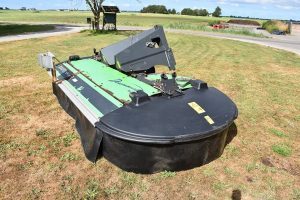Chris McCullough
A Dutch dairy farmer whose cows just recently learned how to graze again after 10 years kept indoors is using a rather novel method to measure his grass yields to ensure he only uses fertiliser where required.
Piet Jan Thibaudier, 31, discovered the pasture reader technology in Australia and adapted it to fit on to a mower that sits on the front of the tractor.
The technology measures the height of the grass when cutting as well as the yield. With this information Piet can draw up a field map that highlights the areas that require fertiliser the most, preventing overuse and saving money.
 Piet milks 185 crossbred cows on 100 hectares near Lemmer in partnership with father Luut and mother Coby. The herd averages 8700kg per cow per year at 4.5% butterfat and 3.65% protein but the goal is to increase this average to 10,000kg with 5% butterfat and 4% protein.
Piet milks 185 crossbred cows on 100 hectares near Lemmer in partnership with father Luut and mother Coby. The herd averages 8700kg per cow per year at 4.5% butterfat and 3.65% protein but the goal is to increase this average to 10,000kg with 5% butterfat and 4% protein.
Years ago, when Piet’s father ran the farm, the cows were switched from a pasture-based system to being kept indoors and fed daily on a zero-grazing ration.
However, as markets progressed, processor Friesland Campina was paying 34 euro cents (NZ 58 cents) a litre for the milk plus a bonus of 1.5 euro cents a litre for milk produced from grazing cows.
When an earlier opportunity also arose for Piet to take over a neighbouring herd of 45 cows and a further 25ha, he jumped at the chance, albeit with the understanding changes to his feeding system was essential.
‘My cows had not been out to the fields in 10 years and had never learned how to graze. It was truly remarkable to see the 45 cows from the neighbour’s herd educate my cows on how to eat grass in a field again.’
That brought his cow numbers up to over 180 and he was running a 20% replacement rate for followers. With the bonus Friesland Campina was offering for milk from cows grazed at grass he decided to let the cows out.
“However, my cows had not been out to the fields in 10 years and had never learned how to graze. It was truly remarkable to see the 45 cows from the neighbour’s herd educate my cows on how to eat grass in a field again.”
The cows are milked twice a day and graze six hours per day. He wants to increase that to 12 hours per day with 150 days grazing in the season. As a result of allowing the herd to graze outdoors, Piet’s fodder costs fell by two euro cents per litre but he knew the farm required a better grassland management plan.
Piet searched online for technology that could help monitor his grass growth and discovered the pasture reader in Australia.
Piet adapted the technology from Australia with Arjan Hulsman to suit his own farming system by mounting the sensors and readers on to his mower mounted on the front of his tractor.
Before the grass is cut the sensors measure the height and yield of the sward as the mower passes over it. This information tells him the weakest parts of the pasture and which areas are needed to fertilise the most. There is also information on pH and humidity.
The reader scans every three centimetres to gain accurate results in the grass crop. Piet strives to achieve 2-2.5tonnes DM/ha.
Thanks to the success of the system Piet became a distributor for the technology in the Netherlands and already has some sales success for the pasture reader which retails for about €5000(NZ$8650).
“I already have five customers,” Piet says, “who are all using the system to monitor their own grass yields and quality.”
Finding the pasture reader on the web is the latest success for Piet who also found his rotary milking parlour online in Denmark. When he was building his new cow barn he decided to look for a secondhand parlour on the internet.
“As luck would have it I found a 26-unit rotary machine that was being taken out of a farm in Denmark.”
It was only two years old but was being replaced by robots. In the end he paid the scrap price of $22,500 and had to replace all the rubber clusters and lines but everything else was relatively new.




